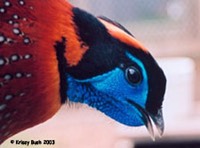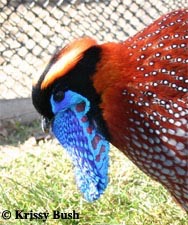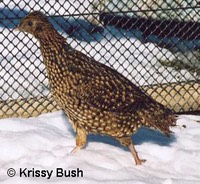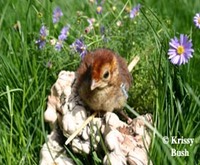Scientific Information
Class: Aves
Order: Galliformes
Family: Phasianidae
Subfamily: Phasianinae
Genus: Tragopan
Species: temmincki
Species English name: Temminck's Tragopan
CITES Status: not listed
Distribution: Himalayas - Northeastern India, Burma, northern Vietnam, and central China
(from A Monograph of Pheasants Volumes I & II, William Beebe)
Description
• Male - Black face, back of the head, and chin. Blue wattles that encompass most of the face and chin. Blue neck skin that unravels to reveal red and purple accents. Orange crest. Orange neck and body with white and black circular spots or smears on the ends of most feathers. Brownish wing and tail tips. Grey beak and pink legs.
• Females- Brown with creamy splashes on the tips of most body and wing feathers. Reddish-pink legs and grey beak.
Diet
• We feed our breeders and young adults 16% layer pellets, our tiny chicks 25% Turkey Starter crumble, and our growing chicks 20% crumble.
• Tragopans love treats of any kind. They get a handful of mixed grains every second day except during breeding season. They also get fresh greens (lettuce, chickweed, dandelions, grass) and fruits & vegetables (tomato, grapes, berries, etc.) when available. They also love mealworms.
Breeding
• Done in pairs. Tragopans are very monogamous birds and become very attached to their mate.
• Temminck's Tragopans are first year birds meaning that the female will lay eggs in her first year. Males are fertile in their first year.
• They start laying eggs in early April and will lay every second day until they lay up to 15-20 eggs.
• They lay very long orangish-tan eggs with brown spots.
Incubation
• Eggs are collected twice a day and marked with the date and breeding pen number and set daily.
• Eggs are set in an automatic turning Lyons Roll-X (RX2) with grid 89
• Temperature 99.8°F, humididty-wet bulb 82 with humidity adjusted periodically depending on development of the air space shown by candling
• On the final day of incubation, each egg is placed in its own oval wire mesh hatching basket (6" x 3" x 3") and set in the Sportsman Ratite hatcher.
• Incubation for Temmincks is 28 days.
• After the chick hatches, it stays in the hatcher for a minimum of 8 hours.
Chicks
• Chicks have a creamy belly and throat with a reddish-brown body (darker and smaller than Satyr chicks).
• They start out in our round 18" brooder pen with a mixed assortment of chicks. After a few days they are separated into an all Tragopan 2' x 4' baby pen for about a week. They are then transferred to an all Tragopan 2' x 6' pen for the next 7-9 weeks. All of these brooding pens have wire bottoms with a heat lamp at one end and feed & water at the other end. The heat lamp is attached to a dimmer switch so we can turn down the amount of heat as the chicks get older until it is turned off completely.
• After they are off of the heat for a few weeks, they are moved outside to the pheasant house (has outside grassy pens and a heated inside house part where they are blocked in for the night). After they are toughened up, they are moved to an outside chick pens.
Pens
• 25' long x 10' wide x 6' high with a 4' x 4' x 4' house in the middle.
• Pens are covered with 2" diamond top-rite.
• Pens contain grass, but need to be mowed since Tragopans are moderate grass eaters.
• See Scintillating Copper Article for predator proofing set-up
Behavior
• They are very easy to tame down and are incredibly friendly and curious birds. Most will tame down enough to eat out of your hand or follow you around. Some learn how to do tricks and one male of ours will sit on my shoulder.
• The males can become aggressive enough to attack humans during breeding season. Some males will continue to attack humans year-round. They generally go for the legs and/or head.
• They are very calm and non-flighty birds that love to show off when any one is watching.
• Male display is probably the neatest of all of the Pheasants that we have. Males will puff up, make angry whining noises, put their head down, peck at the dirt, and gradually unravel their throat skin and reveal their horns. The throat skin of a male in full display can almost touch the ground when he is standing upright.
Article By Krissy & Donna Bush
Pheasant Ridge



